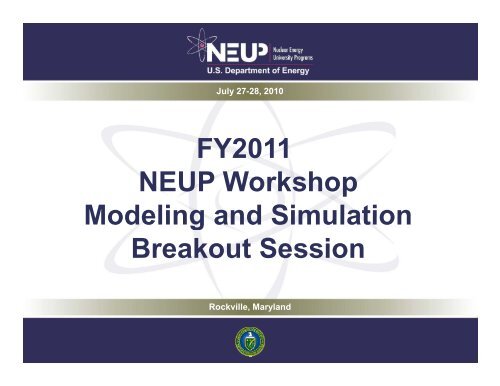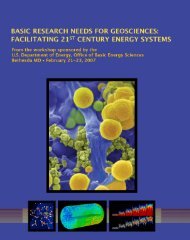neams - Idaho National Laboratory
neams - Idaho National Laboratory
neams - Idaho National Laboratory
You also want an ePaper? Increase the reach of your titles
YUMPU automatically turns print PDFs into web optimized ePapers that Google loves.
July 27-28, 2010FY2011NEUP WorkshopModeling and SimulationBreakout SessionRockville, Maryland
July 27-28, 2010Nuclear Energy AdvancedModeling and Simulation(NEAMS) Reactor IPSCProgram Managers:Presenter:Alex Larzelere, NE-71alex.larzelere@nuclear.energy.govgygRichard Black, NE-74richard.black@hq.doe.govDavid Pointer, Argonne <strong>National</strong> <strong>Laboratory</strong>david.pointer@anl.govRockville, Maryland
NEAMS• Vision• To rapidly create and deploy “science-based”verified and validated modeling and simulationcapabilities essential for the design,implementation, and operation of future nuclearenergy systems with the goal of improving U.S.energy securityDeputy AssistantSecretary for NuclearReactor TechnologiesOffice ofAdvancedModeling andSimulationOffice of LightWater ReactorTechnologiesOffice of GasCooled ReactorTechnologiesOffice ofAdvancedReactor ConceptsFY2011 Nuclear EnergyUniversity Programs Workshop3
NEAMS Organization• Integrated Safety andPerformance Code (IPSC)Development Teams• Reactors• Fuels• Waste Forms• Safeguards andSeparations• Supporting Cross-cut Elements• Fundamental Methods andModels• Enabling ComputationalTechnologies• Verification and UncertaintyQuantification• Capability TransferFY2011 Nuclear EnergyUniversity Programs Workshop4
NEAMS Organization• Integrated Safety andPerformance CodeDevelopment Teams• Reactors• Fuels• Waste Forms• Safeguards andSeparations• Supporting Cross-cut Elements• Fundamental Methods andModels• Enabling ComputationalTechnologies• Verification and UncertaintyQuantification• Capability TransferOffice ofAdvancedReactor ConceptsFY2011 Nuclear EnergyUniversity Programs Workshop5
Motivation and Objective• Apply modern, high-performance techniques to nuclear reactor modeling– Improve turn-around time for reactor design iterations– Understand and reduce uncertainty of computational models– Use advanced simulation tools to improve safety, reduce cost, exploreadvanced designs• Maintain a balanced approach– Allow for both rapid-turnaround reactor-scale calculations (desktop) anddetailed, high-fidelity simulations to augment experiments (petascale)– Deliver near-term capability and insight while also developing next-generationtools and integrated capabilities• Extensive leveraging with other DOE projects– INCITE, SciDAC, ASCFY2011 Nuclear EnergyUniversity Programs Workshop66
REACTOR IPSC• Scope– Predict performance and safetyof reactor over 40-60 yearlifetime– Initial focus on Sodium-CooledFast Reactors (SFR)– Primary development efforts incore modeling, extending to fullsystem– Many underlying physicalprocesses (e.g.thermodynamics, neutronics)extensible to other reactortypes (gas-cooled, light water)FY2011 Nuclear EnergyUniversity Programs Workshop7
Reactor IPSC‣ Develop integratedhigh fidelity multiphysicssimulationcapabilities‣ Verification,validation andbenchmarking ofdeveloped tools‣ Integrated reactorprimary systemsimulationsFY2011 Nuclear EnergyUniversity Programs Workshop8
Reactor IPSC Challenge Problems• Challenge Problem #1: Core Radial Expansion– Important for operational, design-basis, and beyond design-basis transients.– Critical component of passive safety story. Difficult/impossible to measure.– Suspected of playing a role in unexplained PHENIX reactivity transients.– Requires coupled neutronics, thermal hydraulics, and structural mechanics.• Challenge Problem #2: Outlet Plenum Mixing– Critical to normal operations: thermal striping and fatigue, upper internal structureperformance, reactor vessel/head performance, instrumentation and controloptimization– Critical to transients: thermal (SFR/LFR) or density (VHTR) stratification, naturalconvection cooling, decay heat removal, control-rod driveline expansion, core restraintsystem performance– Outlet plenum design may either aid or hinder passive safety performance.– Requires coupled thermal hydraulics and structural mechanics (with impacts onneutronics)FY2011 Nuclear EnergyUniversity Programs Workshop9
Hierarchal Thermal Fluid Simulation System• Apply appropriate scale of resolutionto capture relevant local physicsand/or fit within availablecomputational capacity.• Couple through boundary conditionsand integral engineering modelcoefficients• Codes available to the SHARP virtualreactor– SHARP Driver• SAS4A Libraries– SASSYS1 Subchannel Solver– STAR-CD/STAR-CCM+/OpenFOAMRANS– Nek5000/STAR-CCM+/OpenFOAM/OLES– Nek5000/OpenFOAM DESFY2011 Nuclear EnergyUniversity Programs Workshop 10
Thermal Hydraulics• FY11 Activities– Develop multi-resolution simulation hierarchycomponents– Verification, validation and benchmarking– Core and system component simulations• Needs• Methods to enable extension to other reactor types– High fidelity multi-phase simulation• Reduced order modeling methods for acceleration ofhigh-fidelity simulations– Modal Analysis Using Proper Orthogonal Decomposition• Subgrid models for rod bundle turbulence• High spatial and time resolution validation data• Thermophysical and thermomechanical propertylibrariesFY2011 Nuclear EnergyUniversity Programs Workshop11111
Hierarchal Neutronics ApproachHomogenized assemblyHomogenized assemblyinternalsHomogenized pin cellsFully explicit assemblyFY2011 Nuclear EnergyUniversity Programs Workshop 12 1
• FY11 ActivitiesWhole-core g p pABTRComparison of NeutronSpectra between MC 2 -3 andVIM Monte Carlo SolutionsNeutronics– Deliver a production version of the multi-group crosssection generation code MC 2 -3 by combining the advancedultrafine group spectrum solver and the 2D method ofcharacteristics (MOC) solver of UNIC– Develop an intermediate fidelity flux solver for VHTRanalysis which is based on hexagonal pin-cell geometrywith structured mesh.– Continue to improve the performances of the high-fidelitySn, Pn and MOC solvers of UNIC on high performancecomputers– Needs• Improved x-section data based on nuclear modeling• nucleonic structure calculations to complementexperimental measurements– Minor actinides– Fission fragments for high burnup– High-fidelity co-variance data for use in transport calculations– Fission x-sectionsZPPR-15 Critical ExperimentNEAMS July PMT Face‐to‐Face, Oak Ridge, TN, July 20‐22, 2010FY2011 Nuclear EnergyUniversity Programs Workshop 13 131
System Simulations‣ FY11 Activities• Develop and demonstrate an initial implementationof the SHARP driver code, providing global systemmodeling capability and support for a wide range ofmodeling choices for individual reactor components.• Develop scalable intermediate fidelity (IF) assemblymodeling method to support full‐core transientmodeling coupled to existing and emerging fuelperformance models.• Needs:• Enable parametric analyses like those currently done withsubchannel codes, but utilize information from high fidelitysimulations in place of experimentally derived correlations‐ Time‐stepping strategies for coupledmulti‐scale simulations of transientsystem response‐ Models and methods to enableapplication to other reactor types‐ Multi‐scale validation data withadequate resolution to evaluatecoupling of high and low resolutionmethodsPLOFResultsFY2011 Nuclear EnergyUniversity Programs Workshop 14 1
Framework• FY11 Activities– Development of geometry/mesh generation tools built on a foundation including CUBIT,the MeshKit library, and the STAR series of tools.– Provide capability for boundary/initial condition coupling from systems models to THmodule. Coupling will be performed based on mesh and solution representation in theMOAB mesh library.FY2011 Nuclear EnergyUniversity Programs Workshop 15
The scope for ECT in FY11 spans 4 areasSoftware Quality Assurance Cross‐cut libraries• NEAMS SQA Plan• Pre‐processing tools such as• IPSC risk assessmentsgeometry and meshing• Best practices and tools • Post‐processing tools such as• Centralized server of SQA visualization and data analysistools and consulting expertise • Materials interface and libraryCommon Frameworks• Assess need for commonality acrossIPSC teams• Release/Distribution• Configure/build• Workflow and execution• Data and information• Code coupling• Propose and develop solutionsCompute Cycles• Evaluate INL/ORNL capacitycomputing resources• Improve accessibility and usability• Provide guidance on additionaloptions (e.g. INCITE)FY2011 Nuclear EnergyUniversity Programs Workshop 16
July 27-28, 2010Nuclear Energy AdvancedModeling and Simulation(NEAMS) Reactor IPSCProgram Managers:Presenter:Alex Larzelere, NE-71alex.larzelere@nuclear.energy.govgygRichard Black, NE-74richard.black@hq.doe.govDavid Pointer, Argonne <strong>National</strong> <strong>Laboratory</strong>david.pointer@anl.govRockville, Maryland
















